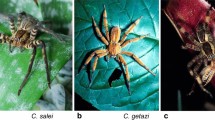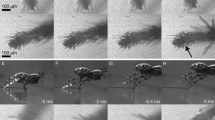Summary
-
1.
The hunting spiderCupiennius salei Keys is able to direct its locomotion by making use of information about its own previous movement sequences (kinesthetic orientation). After a blinded spider is chased ca. 25 cm away from a prey-fly, it returns to the original capture site despite the preclusion of other possible orientation clues. The mean starting direction of such returns differs from the ideal return direction by only 2 ° (Fig. 4a, 5). Of all runs 95% are “successful” in that the animals approach the capture site as close as 5 cm (mean value) (Fig. 3).
-
2.
Mechanical destruction of compound slit sense (“lyriform”) organs on femur and tibia of all legs results in disorientation of the spiders: more than 2/3 of their returns pass the capture site at a distance of more than 10 cm (Fig. 3, 4b). In addition, the mean angular deviation of starting directions increases significantly. The difference between the mean starting angles of the treated groups and the mean of intact animals, however, is significant only in some cases.
-
3.
A special effort was made to evaluate not only thestarting directions and the “success” of a return path, but theentire return route, which is comprised of several path segments based upon each stopping and/or turning point. To this end a “walking error” en was determined for each segment (Fig. 8). For intact animals the error increases abruptly at the point nearest to the capture site. We therefore conclude that the spiders control also their walking distance kinesthetically. In the case of operated animals the mean “walking error” calculated from those segments lying before the “nearest point” increases by a factor of 4 to 5, as compared with intact spiders, whereas it remains about the sameat the “nearest point” itself (Fig. 9).
-
4.
Small holes pierced into the leg cuticle near intact lyriform organs of otherwise intact “control animals” do not influence the success, starting angle, and walking errors of returns.
Similar content being viewed by others
References
Barth, F. G.: Ein einzelnes Spaltsinnesorgan auf dem Spinnentarsus: seine Erregung in Abhängigkeit von den Parametern des Luftschallreizes. Z. vergl. Physiol.55, 407–449 (1967).
Barth, F. G., Libera, W.: Ein Atlas der Spaltsinnesorgane vonCupiennius salei Keys. Chelicerata (Araneae). Z. Morph. Tiere68, 343–369 (1970).
Barth, F. G., Seyfarth, E.-A.: Slit sense organs and kinesthetic orientation. Z. vergl. Physiol.74, 326–328 (1971).
Batschelet, E.: Statistical methods for the analysis of problems in animal orientation and certain biological rhythms. Washington: Amer. Inst. Biol. Sci. 1965.
Burger, M.-L.: Zum Mechanismus der Gegenwendung nach mechanisch aufgezwungener Richtungsänderung beiSchizophyllum sabulosum (Julidae, Diplopoda). Z. vergl. Physiol.71, 219–254 (1971).
Görner, P.: Die optische und kinästhetische Orientierung der TrichterspinneAgelena labyrinthica (Cl.). Z. vergl. Physiol.41, 111–153 (1958).
Görner, P.: Über die Koppelung der optischen und kinästhetischen Orientierung bei den TrichterspinnenAgelena labyrinthica (Clerck) undAgelena gracilens C. L. Koch. Z. vergl. Physiol.53, 253–276 (1966).
Hagen, H.-O. v.: Nachweis einer kinästhetischen Orientierung beiUca rapax. Z. Morph. Ökol. Tiere58, 301–320 (1967).
Jander, R.: Ein Ansatz zur modernen Elementarbeschreibung der Orientierungshandlung. Z. Tierpsychol.27, 771–778 (1970).
Liesenfeld, F. J.: Über Leistung und Sitz des Erschütterungssinnes von Netzspinnen. Biol. Zbl.80, 465–475 (1961).
Markl, H.: Geomenotaktische Fehlorientierung beiFormica polyctena Förster. Z. vergl. Physiol.48, 552–586 (1964).
Melchers, M.: Zur Biologie und zum Verhalten vonCupiennius salei (Keyserling), einer amerikanischen Ctenide. Zool. Jb. Abt. System., Ökol. u. Geogr.91, 1–90 (1963).
Parry, D. A.: The small leg-nerve of spiders and a probable mechanoreceptor. Quart. J. micr. Sci.101, 1–8 (1960).
Pringle, J. W. S.: The function of the lyriform organs of arachnids. J. exp. Biol.32, 270–278 (1955).
Rathmayer, W., Koopmann, J.: Die Verteilung der Propriorezeptoren im Spinnenbein. Z. Morph. Tiere66, 212–223 (1970).
Schmidt-Koenig, K.: Die Sonne als Kompaß im Heim-Orientierungssystem der Brieftauben. Z. Tierpsychol.18, 221–244 (1961).
Stephens, M. A.: Exact and approximate tests for directions. I. Biometrika49, 463–477 (1962).
Vogel, H.: Über die Spaltsinnesorgane der Radnetzspinnen. Jena. Z. Med. Naturw.59, 171–208 (1923).
Walcott, Ch., Kloot, W. G. van der: The physiology of the spider vibration receptor. J. exp. Zool.141, 191–244 (1959).
Author information
Authors and Affiliations
Additional information
Supported by a grant from the Deutsche Forschungsgemeinschaft.
We thank Drs. M.-L. Mittelstaedt-Burger and Ann and John Thorson for helpful discussions.
Rights and permissions
About this article
Cite this article
Seyfarth, E.A., Barth, F.G. Compound slit sense organs on the spider leg: Mechanoreceptors involved in kinesthetic orientation. J. Comp. Physiol. 78, 176–191 (1972). https://doi.org/10.1007/BF00693611
Received:
Issue Date:
DOI: https://doi.org/10.1007/BF00693611




